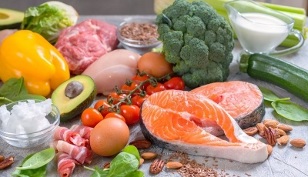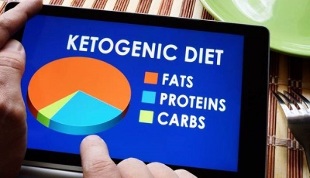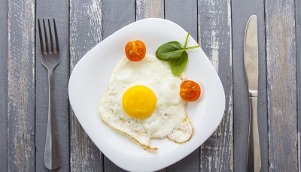
Lack of hunger attacks, a clear mind, and a rapid loss of extra pounds are all benefits of a ketogenic diet. Find out what types of keto diets are and choose the right one for you!
The ketogenic diet is no longer a newcomer to the world of diet and weight loss, but it remains the most controversial method. And all because its adherents are convinced: on fried chicken thighs and juicy chops you can not only lose weight, but also never gain weight. Doctors warn: The keto diet is difficult, dangerous, not fully understood, and has many side effects as well.
The fatty diet came to us from the world of medicine, where it has been used for a very long time to relieve epileptic seizures in children. It is one of the varieties of low carb nutrition programs. However, the main difference between the ketogenic system and the usual one is that fat is the main nutrient in one's diet.
How it works
In good habitual nutrition, the most favorable nutritional ratio(BZhU) is 1: 1: 4, that is, carbohydrates are the basis of the diet. They are the main source of energy (calories) and are needed by the nervous system as a source of glucose. However, numerous studies confirm that this is not entirely true. Swedish scientists have shown that as a result of increased fat and protein, as well as the rejection of saccharides after depleting its own glycogen stores, the body goes into another "mode". The usual metabolism is rebuilt and carbohydrates are no longer the main source of energy. The liver produces a special form of acetone called ketones (ketone bodies), which moves with the bloodstream and affects the oxidation of fatty acids. As a result, our body goes into a state of ketosis and extracts energy not from carbohydrate chains, but from fat processing products, by depleting subcutaneous fat first, then using fat from food. The experiments of scientists confirmed that ketones are more of a physiological fuel for the brain, while sugars, on the contrary, are cheap and fast energy, which in the future is the cause of degenerative diseases of the brain.
After overwhelming research results, professional athletes and bodybuilders became interested in this method. Ket food began to gain popularity and moved from a diet to a lifestyle promising rapid weight loss, strengthening and increase in muscle mass, the absence of constant hunger and, as a result, adifferent life.
However, despite its effectiveness, doctors warn: the ketogenic diet is associated with the calculation of nutritional standards, so it is prescribed and monitored by a nutritionist. It is important to properly start, maintain, and control ketosis. Composing a menu program yourself is putting your health at risk!
Main views
Professional athletes distinguish three main types of ketogenic diets:
Standard (SKD - standard ketogenic diet)

This is a basic linear program with moderate to high protein intake, high fat intake and low saccharide intake in the diet. It is characterized by a constant supply of ketogenic nutrients without periods of carbohydrate replenishment. SKD is ideal for people with low activity (sedentary lifestyle, irregular exercise).
How to calculate the nutritional balance? Take, for example, the standard ketogenic diet of a 75 kg person with exercise intensity 2-3 times per week.
- First, let's calculate the daily calorie intake (KRday). For our example, this will be around 2000 kcal / day.
- The number of proteins required (Bsut) is 2 grams per 1 kg of weight, that is to say for our example Bsut = 2 * 75 = 150 grams / day.
- The daily amount of carbohydrate (Usut) is 0. 2-0. 4 grams. for 1 kg of weight, that is, 15-30 grams / day (we will take the norm of 30 grams for calculations).
- Let's calculate how many calories in the daily diet come from protein and glycides. Each of these nutrients is known to contain 4 calories per gram. Therefore, in our calculation, this value is (150 + 30) * 4 = 720 kcal.
- As you can see, for our example, a person should get 1280 kcal (2000-720) from fat. And since 1 gram of fat contains 9 kcal, then the daily amount of fat (F / day) = 1280/9 = 142 grams.
As a result of calculations, we determined that for this situation, the diet should consist of 150 grams of protein, 30 grams of carbohydrate and 142 grams of fat, evenly distributed between meals.
Cyclic (CKD- cyclic ketogenic diet)
An option for experienced bodybuilders who feel good about their body and understand good nutrition, calories, and diet rules. CKD is suitable for athletes who train daily and report decreased training effectiveness in the context of core and target systems. The purpose of this method is to determine the correct period between the days of carbohydrate load (replenishment) and to calculate the amount of carbohydrate that will allow you to work on your body at maximum intensity.

Bodybuilders recommend gradually introducing renewals, starting with one per week, and monitoring your well-being by adjusting the time interval between loads according to individual needs. Note how many carbohydrates were consumed in food each day and note the general well-being.
The main rule of the loading day: a decrease in the W / day indicator while the B / day must remain unchanged (or increased). U / day depends on individual insulin sensitivity and is 2-3 g per 1 kg with low, 4-5 g per 1 kg with normal and 6-7 g per 1 kg with high sensitivity.
Let's calculate the calorie content of CDC with normal insulin sensitivity for our example.
- B / day = 2 * 75 = 150 grams / day.
- A / day = 450 to 525 grams / day.
- The daily calorie content of proteins and sugars on the day of carbohydrate load is (150 + 450) * 4 = 2400 kcal.
- As in the previous calculation, we calculate the remaining calories, divide the resulting number by 9, and get the number of grams of fat to include in the diet on carb days.
Thus, the calculations showed that during 6 days of the CKD the menu will be built as in the CKD, and one day (carbohydrates) the calorie content will be 2500 kcal (150 g of protein, 300 g of carbohydrates and 78g fat)
Target ketogenic diet TKD
Suitable for long-term athletes whose performance drops dramatically after a long period without glycides and who may benefit from low carbohydrate intake. It is characterized by a short-term "injection" of saccharides during the so-called "training window" (ie before and after training), which will increase endurance, but not suppressthe process of ketosis. The goal of targeted ketogenic nutrition is to provide a short term increase in performance and endurance. In the absence of training, SKD indicators are taken.
Let's calculate Y / day before and after training for our example:

- B / day = 2 * 75 = 150 grams / day.
- The increase in Y / day depends on insulin resistance and is +0. 5 g for 1 kg with low sensitivity, +0. 75 g for 1 kg with normal and +1 g for1 kg weight with high sensitivity. It is recommended that you divide these extra carbohydrates into two equal parts and eat before and after training.
- As in the previous calculations, subtract the daily calories of protein and carbohydrate from the total calories of the diet. The resulting delta will be the calories attributable to fat.
Warning!This calculation is not a rule, but just an example. The calculation of indicators for the basic menu should be based on individual characteristics, and the fine-tuning of targeted and cyclical ketogenic diet replenishments is carried out exclusively by trial and error based on well-being, performance indicators, theendurance, intensity and duration of the training period. If you are unsure of your abilities and experience, we recommend that you contact a nutritionist.
Rules
To get the desired weight loss results, follow these guidelines:
- Start by fasting for one day. Only water is allowed.
- The diet should include: "correct" fat - 60%, protein - 30%, carbohydrate at least 10% of the daily calorie intake.
- Mandatory intake of vitamins and minerals (calcium, vitamin D, folic acid).
- Drink as much as possible.
- To consume foods from the authorized list.
Authorized and prohibited products
The onset and maintenance of ketosis is facilitated by:
- high-fat fermented dairy products (including cottage cheese);
- lard, fatty meats, poultry with skin; sausages
- (ham, balyk, boiled pork);
- fish (preferably fatty) and seafood;
- hard cheeses (try to choose cheeses with a minimum of carbohydrates);
- lawyer;
- oils (butter, unrefined vegetable oils, coconut); mushrooms
- ;
- high fiber vegetables;
- bananas;
- nuts, nut butters;
- pumpkin seeds;
- leafy salads.
Minimum allowed:
- dark and bitter chocolate with maximum cocoa content and minimum sugar;
- raw roots, vegetables, fruits which have not undergone heat treatment;
- tea, coffee.
Prohibited products:
- carbonated drinks;
- sugar, honey;
- bakery products, bread;
- cereals;
- dried fruits;
- skimmed milk, kefir, yogurt;
- margarine, spread;
- pasta;
- starchy vegetables.
Menu

When developing a menu for a week for a ketogenic diet, nutrition experts recommend not focusing on the weight of the food, but making a menu based on its volume andto calculate the ratio of BJU.
Approximate ketogenic menu for a week, taking into account recommendations.
Monday
- Breakfast: scrambled eggs of 2 eggs; hard cheese; Bacon; a cup of coffee.
- Lunch: vegetable salad (leafy "Iceberg" + cucumber + celery) seasoned with mayonnaise; fried chicken with skin; hard cheese.
- Dinner: steak; cooked cauliflower with mushrooms; coffee with cream.
Tuesday
- Breakfast: escalope; hard cheese; cup of americano with milk.
- Lunch: salmon steak with creamy sauce; steamed broccoli; Lettuce salad with cheese and eggs, seasoned with mayonnaise.
- Dinner: pork chop; cooked cabbage; vegetable salad; tea.
Wednesday
- Breakfast: 6-egg omelet with grated cheese (can be replaced with a protein shake); soy milk - 0, 5 l.
- Lunch: smoked brisket; Fried zucchini with cheese.
- Dinner: red fish with cream sauce; vegetable salad with mayonnaise; yogurt.
Thursday
- Breakfast: boiled eggs - 4-5 pieces; any sauce - 2-3 tbsp. spoons; vegetable salad with cheese.
- Lunch: mushrooms cooked in sour cream; spinach salad; Fried fish.
- Dinner: meat steak; toast with honey; Milk.
Friday
- Breakfast: scrambled eggs (3-4 eggs); protein drink; hard cheese.
- Lunch: scrambled eggs; fried chicken breast; hard cheese.
- Dinner: salmon; unroasted almonds; salad.
Saturday
- Breakfast: salmon; grapefruit; salad.
- Lunch: fish; vegetable stew; mixture of nuts.
- Dinner: vegetable salad; some sausages; cheese.
Sunday
- Breakfast: eggs in a bag; cheese; vegetable salad.
- Lunch: turkey; tomato salad with mayonnaise; cheese.
- Dinner: cottage cheese; grapefruit.
Make sure you stick to your drinking regime. Drink at least 1. 5 liters of water throughout the day.
Contraindications and side effects
For several days after starting a ketogenic diet, you may feel weak, lethargic, and depressed. Such nutrition is not natural and therefore particularly dangerous for a growing organism. For adolescents, this food is categorically contraindicated. With a long-term or inappropriate ketogenic diet, the following side effects may occur:
- urolithiasis;
- increased levels of bad cholesterol in the blood;
- violation of peristalsis, functional state of the gastrointestinal tract (gastroesophageal reflux disease);
- dehydration (since carbohydrates remove excess water);
- growth retardation (in adolescents) due to lack of protein;
- vitamin deficiency;
- lack of minerals and therefore bone remineralization, osteoporosis;
- inflammation of the pancreas (pancreatitis);
- hormonal imbalance and menstrual cycle failure;
- ketoacidosis.
Therefore, in order to avoid the development of pathological diseases and exacerbation of existing diseases, the diet is controlled by a specialist. When losing weight, monthly monitoring of the disease is recommended, the delivery of basic tests (blood, urine). The correction of the ketogenic diet or its cancellation is carried out by the doctor depending on the results of the examination.




























